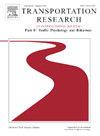When is more actually better? expert opinions on assessment of situation awareness in relation to safe driving
IF 3.5
2区 工程技术
Q1 PSYCHOLOGY, APPLIED
Transportation Research Part F-Traffic Psychology and Behaviour
Pub Date : 2024-11-26
DOI:10.1016/j.trf.2024.11.011
引用次数: 0
Abstract
The use of situation awareness (SA) measures to assess relative safety in driving is common, with higher levels of SA being interpreted as safer. These relative interpretations do not allow researchers to determine whether the level of SA could be considered “safe” or “unsafe”. In contrast to such interpretations based on relative performance, the current position paper explores the potential for a normative interpretation of situation awareness with regard to safety assessment in driving. A series of expert interviews yielded viewpoints on the current relation between SA and safe driving, theoretical underpinnings for a normative approach, and potential actions towards an SA criterion for safe or unsafe driving. Methodological challenges regarding a normative approach are discussed together with considerations towards a weighted criterion-based approach to SA. The selection of SA requirements relevant for safety and the differentiation and weighting of these requirements on high and lower importance is presented. A method towards objective determination of relevance and weight of SA requirements may increase the usefulness of SA measures for assessment of safety in a driving context.
专家对与安全驾驶有关的情境意识评估的意见
使用态势感知(SA)测量方法来评估驾驶的相对安全性很常见,态势感知水平越高越安全。这些相对解释并不能让研究人员确定 SA 水平是 "安全 "还是 "不安全"。与这种基于相对表现的解释不同,本立场文件探讨了在驾驶安全评估方面对情境意识进行规范性解释的可能性。通过一系列专家访谈,我们了解了当前安全驾驶意识与安全驾驶之间的关系、规范方法的理论基础以及安全驾驶或不安全驾驶意识标准的潜在行动。此外,还讨论了规范性方法所面临的方法论挑战,以及基于加权标准的 SA 方法的考虑因素。介绍了与安全相关的 SA 要求的选择,以及这些要求在高重要性和低重要性方面的区别和权重。客观确定安全标准要求的相关性和权重的方法可提高安全标准措施在驾驶安全评估中的实用性。
本文章由计算机程序翻译,如有差异,请以英文原文为准。
求助全文
约1分钟内获得全文
求助全文
来源期刊
CiteScore
7.60
自引率
14.60%
发文量
239
审稿时长
71 days
期刊介绍:
Transportation Research Part F: Traffic Psychology and Behaviour focuses on the behavioural and psychological aspects of traffic and transport. The aim of the journal is to enhance theory development, improve the quality of empirical studies and to stimulate the application of research findings in practice. TRF provides a focus and a means of communication for the considerable amount of research activities that are now being carried out in this field. The journal provides a forum for transportation researchers, psychologists, ergonomists, engineers and policy-makers with an interest in traffic and transport psychology.

 求助内容:
求助内容: 应助结果提醒方式:
应助结果提醒方式:


